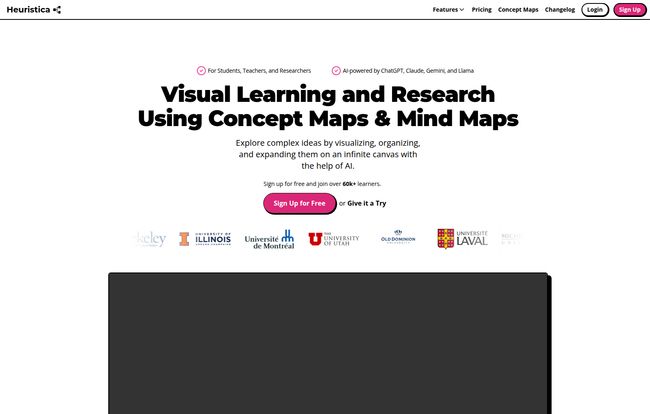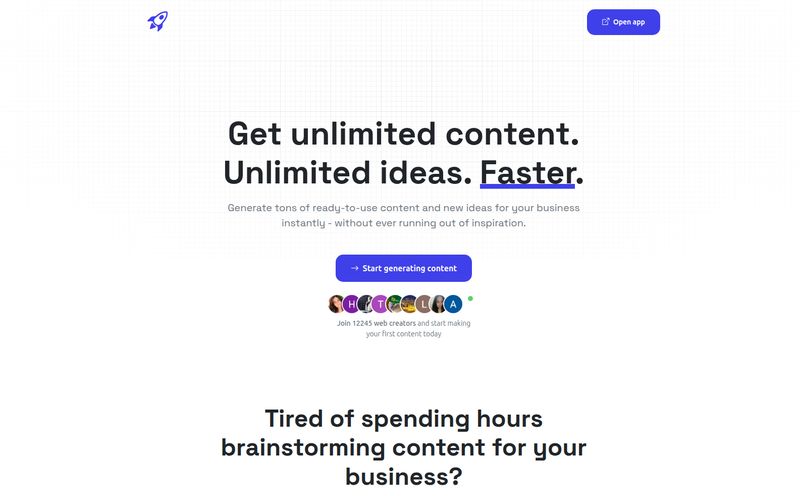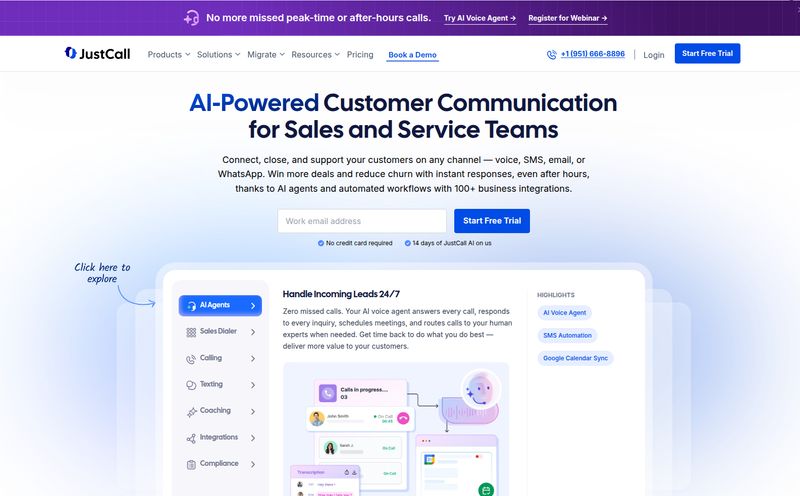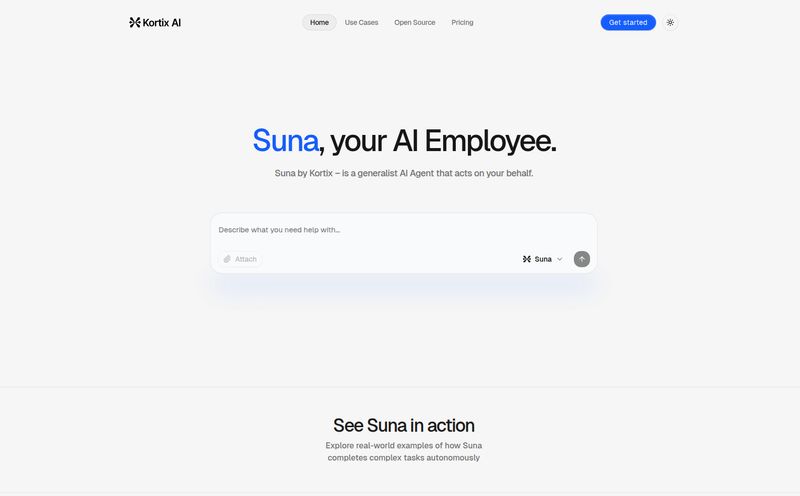The start of any big project—be it a research paper, a new content strategy, or even just studying for a monster exam—is pure chaos. My desk (and my brain) often looks like a conspiracy theorist's wall, covered in scribbled notes, with a million browser tabs open, each one a rabbit hole promising answers but usually just delivering more confusion. For years, I’ve been searching for something to tame this creative storm. A tool that doesn’t just store my ideas, but helps me connect them.
A few weeks ago, I stumbled upon a tool called Heuristica. The name itself, hinting at problem-solving and discovery, caught my eye. It promised AI-powered mind mapping for visual learning and research. My first thought? “Oh, great. Another mind map app.” But I was wrong. Dead wrong.
This isn't just a digital whiteboard. It’s more like a research partner. A co-pilot for your brain that can sift through academic journals, YouTube videos, and news articles to help you build a visual web of knowledge. And I've got to say, it’s been a bit of a game-changer for me.
So, What is Heuristica, Really?
At its heart, Heuristica is an AI-powered concept mapping tool. You start with a central idea—say, “Quantum Computing” or “Sourdough Baking”—and the AI helps you branch out, exploring related topics, asking questions, and pulling in information from all over the web. It all happens on this gorgeous, infinite canvas that lets your ideas breathe.
Think of it this way: You know that feeling when you're trying to explain a complex idea and you start waving your hands around, drawing invisible diagrams in the air? Heuristica takes that frantic energy and turns it into a clear, organized, and interactive map. It’s the closest thing I've found to a tool that thinks with me, visually.

Visit Heuristica
The Features That Actually Make a Difference
I’ve tested a lot of productivity and research software. Most are bloated with features I’ll never touch. Heuristica is different. Its feature set feels intentional, built for people who are actually trying to learn or create something new.
The AI-Powered Infinite Canvas
This is the main event. You drop a topic onto the canvas and ask the AI to expand on it. It generates connected nodes, creating a web of information. You can ask it to generate subtopics, explain a concept in simpler terms, or even come up with counterarguments. It’s an interactive brainstorming session. I spent an hour mapping out a content cluster for “CPC optimization,” and the AI suggested angles I hadn’t even considered. It’s genuinely useful for breaking through creative blocks.
A Research Hub with Deep Integrations
Now, this is what made me sit up and pay attention. Heuristica can pull data directly from some serious sources. We’re talking Wikipedia, arXiv, PubMed, and Semantic Scholar for the academic crowd. But it doesn’t stop there. It also integrates with YouTube, Podcasts, and general News/Links. You can even upload your own PDFs on the pro plan!
This transforms the tool from a simple mind mapper into a powerful research environment. For a PhD student working on their dissertation, pulling directly from arXiv is huge. For a content creator like me, being able to paste a YouTube URL and have the AI map out its key points is an incredible time-saver. You're not just brainstorming in a vacuum; you're building your map with sourced, credible information without ever leaving the app.
From Messy Map to Polished Content
Once your beautiful, sprawling concept map is built, what then? This is where Heuristica delivers its knockout punch. It can take your map—your web of interconnected ideas—and automatically generate study materials or content drafts. It can create summaries, full-blown essays, blog posts, quizzes, and even flashcards. I tested this by turning my content map into a blog post outline, and while it needed a human touch (as all AI content does), it gave me a fantastic, well-structured starting point in seconds. This feature alone is a massive productivity booster.
Let's Talk Models and Money: The Pricing
Alright, the all-important question: what's it gonna cost? Heuristica has a straightforward two-tier system, which I appreciate. No confusing add-ons or hidden fees.
Here’s a quick look at the plans:
| Plan | Price | Key Features |
|---|---|---|
| Basic | Free | Basic AI mapping using the Llama 3 (70B) model. It's great for getting a feel for the tool, but you're limited to saving only 3 maps. |
| Professional | $6.99 /month | This is where the magic happens. You get 100 saved maps and access to a whole suite of top-tier AI models, including GPT-4o, Claude 3.5 Sonnet, and Gemini 1.5 Pro. All the integrations (PDFs, YouTube, etc.), content generation tools, and chat features are included here. |
My take? The free plan is a perfect test drive. But if you're a serious student, researcher, or content creator, the Professional plan at $6.99 a month is an absolute steal. The cost of a couple of coffees gets you access to premium AI models and a tool that can genuinely save you hours of work each week. For me, its a no-brainer.
My Honest Take: The Good and The Caveats
No tool is perfect, and I believe in giving a balanced view. After using Heuristica pretty intensively, here's where I land.
What I Love
The visual, interconnected way of working is just chef's kiss. It matches how my brain works. The sheer breadth of integrations in the pro plan is fantastic, making it a one-stop shop for initial research. And the ability to go from a chaotic brainstorm to a structured outline or quiz is something I haven't seen executed this well anywhere else.
The Things to Keep in Mind
First, let's be real: AI can get things wrong. Large Language Models can produce inaccurate information, or what the community calls 'hallucinations'. Heuristica is pulling from sources, which helps, but you should always, always double-check the facts, especially for academic or critical work. Think of it as a brilliant but sometimes forgetful research assistant. Second, the free plan is pretty restrictive. It gives you a taste, but the 3-map limit means you'll hit a wall quickly if you're using it for real projects. Lastly, it’s an online tool, so no internet means no Heuristica. Not a huge issue for most, but something to be aware of.
Who Is Heuristica Actually For?
I can see a few groups of people falling head-over-heels for this tool.
- Students: Drowning in dense textbooks and lecture notes? Use Heuristica to break down complex subjects visually. The quiz and flashcard generation could be your secret weapon for exam prep.
- Academics and Researchers: The integrations with arXiv, PubMed, and Semantic Scholar are killer features for literature reviews. Mapping out research papers and seeing the connections between them could seriously speed up your workflow.
- Content Creators and SEOs: This is my world. It's incredible for brainstorming topic clusters, outlining articles, and repurposing content. Drop in a competitor's article or a popular YouTube video and instantly see the structure and key talking points.
Frequently Asked Questions About Heuristica
How does Heuristica's AI actually work?
Heuristica uses advanced Large Language Models (like GPT-4o and Claude 3.5 Sonnet in the Pro plan) to understand your requests. When you ask it to expand on a topic, it processes the concept and pulls information from its integrated knowledge bases (like Wikipedia or YouTube) to generate relevant, connected ideas on your map.
Is Heuristica better than just using ChatGPT?
They serve different purposes. ChatGPT is a conversational text generator. Heuristica is a visual thinking environment. While you could ask ChatGPT to outline a topic, Heuristica lets you see the connections visually, rearrange ideas with your mouse, and directly integrate and source information from specific databases, which is a more powerful workflow for research and learning.
Can I upload my own documents?
Yes! The Professional plan allows you to upload your own PDF files. This is amazing for analyzing your own research papers, course materials, or project briefs and integrating them into your concept maps.
How reliable is the information it generates?
It's as reliable as the source it's pulling from, with the added caveat that AI models can sometimes misinterpret or summarize information imperfectly. It's a fantastic starting point, but for any critical work, you should always click through to the original source (which Heuristica often provides) and verify the information yourself.
Is the professional subscription worth the monthly cost?
In my personal opinion, absolutely. If you're a student, researcher, or someone who creates content for a living, the time you save and the clarity you gain are easily worth the $6.99 per month. The access to multiple premium AI models alone is worth more than that.
The Final Verdict
I’m genuinely impressed with Heuristica. It’s a beautifully designed tool that understands a fundamental truth: our brains don't think in linear documents. We think in webs, in connections, in explosions of ideas. Heuristica leans into that, giving us a digital space to capture that beautiful mess and then, with the help of some very smart AI, organize it into something clear and useful.
It’s not going to write your PhD thesis for you, but it might just be the best partner you could ask for while you do. If you're looking for a way to untangle complex ideas and supercharge your research and learning process, you owe it to yourself to give Heuristica a try.



